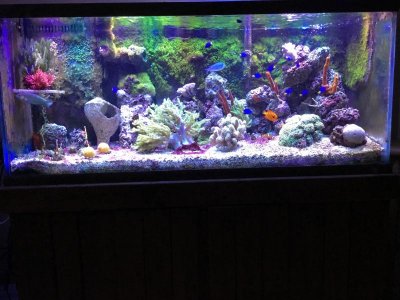Yesterday was a bummer. The night before last, we used water from the DT for in next iteration of the QT, and fed the QT tank before we moved everyone to the new setup.
Temp and salinity were on point, and other than the yellowish tint of older water from the DT, the two tanks were identical.
When I woke up in the morning and checked on the QT before I left for work, I found that the emerald crab had died. I'm sure I'll never know exactly why... but here are some things I suspect...
1. He starved to death. Other than day 1 of arrival at my house, I had only ever seen him actually eating on the night before he died. I was actually very surprised to see him out from under his Millennium Falcon rock, as he never seemed to want to come out from under it. He really seemed to hate the glass bottom of the tank, and clung to the rock all the time, hanging upside down. I had presumed that he was coming out at night to eat, or at times when I wasn't watching... but after recalling how actively he was prowling the initial live rock that was in the tank, and how, after a single day of that, he had burrowed back into the big live rock (the one we eventually removed) and never came out anymore... I'm not sure that was the case.
2. Perhaps there was too drastic of a pH difference between the QT they had been in, and the DT water they were moved into? I find this hard to believe, even though I did not check it. The DT pH has been quite stable, and they were only in the QT for a total of 3 days with the freshly mixed saltwater.
I know it's possible that it was just 'his time' but I don't believe that. When we purchased him and on Day 1 in QT, he was quite active and eating voraciously. After that day though, we hardly saw him again. I think something about the QT was not suitable for him... but I'm not sure exactly what. I know that he was very familiar with his sandy substrate at the LFS, and he really did not like walking on the glass... but can that really be it? Is it possible that he just couldn't acclimate or bring himself to move around in a tank that was now populated with a bunch of other creatures? I have no idea.
It's a real bummer though, because he was the primary reason I went to the fish store that day, and my favorite CUC member. When I left work to head out and buy them, I said "Well... I'm off to buy a crab!"


